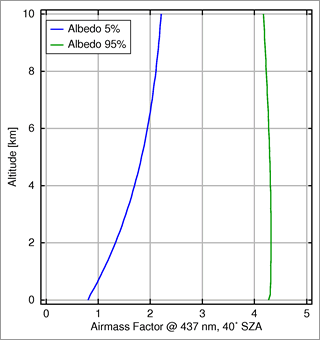The variation of the airmass factor with altitude depends critically on the surface reflectivity or albedo. As discussed in the last section, the sensitivity close to the surface is low over dark surfaces. This is the result of increasing scattering. A rough estimate of how many photons are scattered at 437 nm (20%) compared with a typical surface reflectivity at 437 nm (5%) illustrates that only one out of five photons detected by the satellite originates from surface reflection. This changes over bright surfaces such as ice or snow which can have an albedo of 80% and more. Here, four out of five photons are from surface reflection, and therefore the airmass factor does not decrease towards the ground.
As can be seen from figure xxx, the opposite is the case - the airmass factor is even larger in the lower layers. This is the result of light path enhancement by multiple scattering as already discussed in section xxx.

Fig 3.4.3.3.1:
Image: AT2-ELS
In conclusion, surface reflectivity is a critical parameter to get the right airmass factor. Surface reflectivities are usually taken from climatologies produced from long term satellite measurements which have been thoroughly screened for cloud influence. Still, for an individual measurement the real value might strongly deviate from the climatological one, e.g. in case of fresh snow.